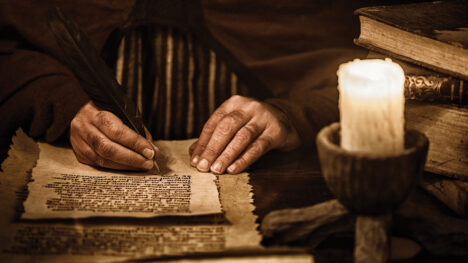An Extraordinary Woman
July 1, 2009
By any standard, Avy Curley lived an extraordinary life and one worth noting.
Born in 1912, she married in 1927, mothered 18 children, did a lot for her community, then, in 1980, received the Medal of the Order of Australia.
Add to that the following: amazing fundraiser for the Royal Flying Doctor Service; founder of the Bundi Club (where Aboriginal people still meet, serve and learn); and proficient in Indigenous artwork. She is also the “mother” of Karalundi Aboriginal Education Centre in outback Western Australia, which for more than 50 years has been a centre of Aboriginal education in the state.
Avy’s grandfathers—one a Scot, the other Irish—were convicts; their wives were both Aborigines. Avy’s parents— Charlie and Bessie Cameron—were members of the Yamatji people who lived and worked on cattle stations and in communities near Geraldton, Western Australia.
Despite challenges in her life, Avy was fortunate, for Charlie was a man with strong religious convictions. He often worked in the courts, assisting in cases involving his people.
“My father adopted both cultures with pride,” recalled Avy. “He was a staunch Church of England man, who brought us up in the church teachings and principles, living by Aboriginal lore and respecting that. People came to him from all walks of life, seeking help in one way or another for different things; he never turned anyone away. He believed in justice—that everyone should be treated as equal no matter their colour.”
Importantly, Charlie insisted that Avy read the newspaper to him each day. His determined preoccupation with education led to clashes with authorities, who didn’t believe Aborigines were worth the trouble. But his mindset resulted in Avy being enrolled in the Mullewa State School—the first Aborigine to do so.
It was a time of rigorously applied segregation. Racism was the norm in Avy’s early years, giving a spark to her fiery passion for education, equality and justice later in life.
“Education is the only way,” she once said. “I fought a long time, getting inspiration from my father to have our children allowed into schools, and finally won.”
Avy’s life was, in some ways, a rollercoaster ride. The highs were education and learning, with a loving and supportive family who always had some sort of roof over their heads. Despite the closeness of her extended family, Avy was in some ways doomed to follow a well-worn path of tradition; that girls were expected to accept a secondary role in life.
“My only regret is I had to leave school to get married, as my first baby was on the way. I was 14; still a child myself,” she reflected.
She experienced and witnessed harsh initiations, learned tribal customs, traditional medicine and food gathering.
She recalled overhearing, as an impressionable young girl, conversations in which her father and his fellow initiates openly discussed the horrors of cannibalism.
She also remembered, with unusual clarity, the tribal customs relating to death and burial. “Funerals have a deeper cultural aspect or meaning for Aborigines and, indeed, other indigenous races. For the Aborigine, it goes back to the time we refer to as the Dreamtime.”
She married George Curley in 1927. He worked around the Yalgoo area.
After a simple wedding, for many years they struggled to make ends meet.
One way of earning money was “blowing” for gold. The technique Avy used was to lay on her side in a dry river bed, move stones away from a potential strike and gently blow the sand away. The resulting specks paid for the essentials of life. Her arduous efforts were greatly improved when her brother, Leedham, helped out.
“He put pieces of board and tin together and made a dry blower, which was a relief, and an easier way to find gold than being on your hands and knees in the creek, blowing out potholes.”
Her early married life was extremely harsh as George struggled to maintain regular employment as a stockman. He worked on 22 stations, the jobs ranging from mustering and shearers’ cook to horse-breaker and fencing. Home was chaff bags sewn together, some sheets of corrugated iron and forked mulga sticks as a frame.
“The hardships of everyday life for Aborigines in those days seemed like the hardest times we could remember,”
she lamented. After losing her second child to measles, Avy recalled, “I don’t know how long I cried. It took a long time to fully understand the meaning and acceptance of my baby’s passing, but life had to go on.”
By 1940, Avy had had enough of being a second-class citizen. The catalyst was a town curfew. The township of Mount Magnet had imposed a time limit on Aborigines visiting the township.
This meant that after 6 pm, they were not permitted on the streets, even if they needed food from a shop. One evening, in town after sunset, with a baby on her hip, and with George and some 20 friends and family in tow, she marched in protest down the main street of the town.
“We just strolled along at a leisurely pace,” she said. “Other white friends joined the group. It was a day to be remembered for all Aborigines, as they made their first stand for justice.
“I felt proud to have been there to lead them down the street,” she said.
In an era when protests were unheard of, this was an astonishing event. They were thrown into the town gaol and later fined






